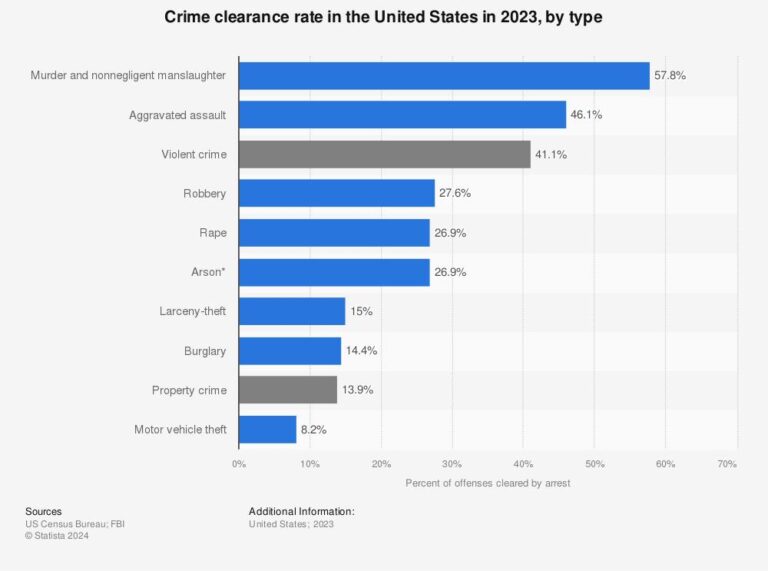Examining U.S. Crime Clearance Rates in 2023: Emerging Patterns, Key Challenges, and Effective Strategies
Variation in Crime Solving Success by Offense Type
Data from 2023 highlights significant disparities in how effectively U.S. law enforcement agencies resolve different categories of crime. The clearance rate‚ÄĒdefined as the proportion of reported crimes that are closed through arrest or other legal actions‚ÄĒdiffers markedly depending on the nature of the offense. Violent crimes, especially homicides, consistently show higher clearance percentages, largely due to prioritized investigative efforts and dedicated task forces. Conversely, property crimes such as theft and burglary remain notoriously difficult to solve, often due to limited physical evidence and low witness engagement.
Key statistics from the latest reports include:
- Homicide: Clearance rate stands at roughly 62%, the highest among major crime categories.
- Sexual Assault: Approximately 41%, impacted by underreporting and investigative hurdles.
- Aggravated Assault: Around 49%, with notable regional differences.
- Burglaries and Larcenies: Below 15%, reflecting difficulties in tracing stolen property and scarce forensic leads.
| Offense Type | 2023 Clearance Rate (%) |
|---|---|
| Homicide | 62 |
| Sexual Assault | 41 |
| Aggravated Assault | 49 |
| Burglary | 13 |
| Larceny | 12 |
Key Barriers Limiting Crime Case Closures
Law enforcement agencies across the country confront numerous obstacles that hinder their ability to resolve cases efficiently. Complex crimes such as cyber offenses, drug trafficking, and organized crime syndicates present intricate investigative challenges. Moreover, many departments operate under tight budget constraints and staffing shortages, limiting their capacity to dedicate sufficient time and resources to each case.
Major factors affecting clearance rates include:
- Technological gaps: Agencies often lag behind criminals in adapting to rapidly evolving digital crime techniques.
- Resource limitations: Budget shortfalls restrict hiring and access to advanced investigative technologies.
- Legal hurdles: Complex judicial processes and high evidentiary standards can delay or complicate case resolutions.
| Crime Type | Estimated 2023 Clearance Rate | Primary Challenge |
|---|---|---|
| Violent Crime | 45% | Limited witness cooperation |
| Property Crime | 20% | Inadequate evidence collection |
| Cybercrime | 15% | Shortage of technical expertise |
Innovative Strategies to Boost Clearance Rates in Difficult Crime Areas
Criminal justice professionals emphasize the necessity of targeted approaches to raise clearance rates, especially for offenses with persistently low resolution figures. Property crimes and drug-related offenses, which often have clearance rates below 40%, require enhanced investigative techniques and better allocation of resources. Employing state-of-the-art forensic technology, strengthening community partnerships, and fostering collaboration between agencies are among the most effective methods to close these gaps.
Suggested measures include:
- Modernizing forensic labs with the latest analytical tools to speed up evidence processing.
- Providing specialized training in areas such as behavioral analysis and cybercrime investigation.
- Enhancing community engagement to encourage witness cooperation and intelligence sharing.
- Leveraging data analytics to prioritize resources on high-impact unsolved cases.
| Crime Category | 2023 Clearance Rate (%) | Recommended Strategy |
|---|---|---|
| Burglary | 34.7 | Utilization of advanced forensic methods |
| Drug-Related Crimes | 29.3 | Undercover operations combined with integrated data platforms |
| Theft | 37.9 | Community-driven intelligence programs |
Policy Focus: Enhancing Community Collaboration and Embracing Modern Investigative Technologies
Recent policy analyses underscore the vital importance of community involvement in improving crime clearance outcomes. Building trust between law enforcement and local communities is crucial for timely information sharing and cooperative investigations. Initiatives such as neighborhood watch groups, public safety forums, and dedicated liaison officers empower citizens to actively participate in crime prevention and resolution efforts.
In parallel, law enforcement agencies are increasingly adopting cutting-edge investigative tools. Technologies like predictive analytics, enhanced forensic techniques, and digital case management systems have proven to accelerate and improve the accuracy of investigations. The table below demonstrates the measurable benefits of combining community engagement with technological advancements on clearance rates in 2023:
| Crime Type | Clearance Rate Before (%) | Clearance Rate After (%) | Implemented Initiative |
|---|---|---|---|
| Burglary | 30 | 45 | Community Watch & Forensic Technology Upgrades |
| Assault | 55 | 70 | Predictive Policing & Community Liaison Programs |
| Motor Vehicle Theft | 25 | 40 | Data-Driven Analytics & Public Alert Systems |
Final Thoughts: Driving Crime Resolution Forward Through Innovation and Partnership
The 2023 clearance rate data from across the United States reveals notable differences in law enforcement’s effectiveness at solving various crimes, highlighting ongoing challenges related to investigative resources and case complexity. While violent crimes generally achieve higher closure rates, property and cyber-related offenses continue to lag, underscoring the need for targeted solutions. Moving ahead, a strategic blend of community engagement, technological innovation, and data-informed policies will be critical to improving clearance rates and ensuring justice is served across all crime categories.




